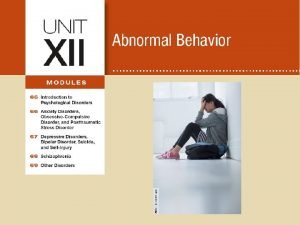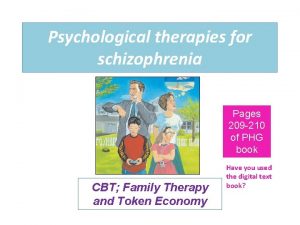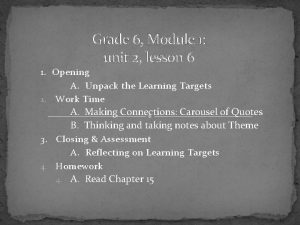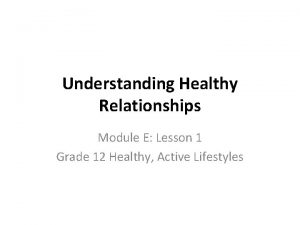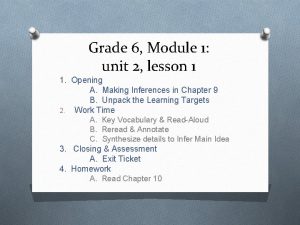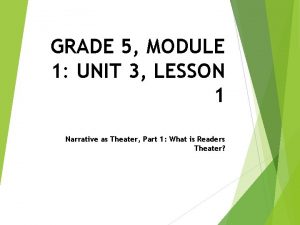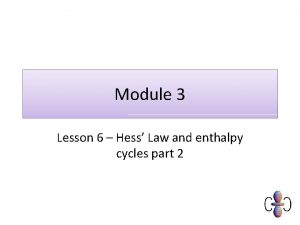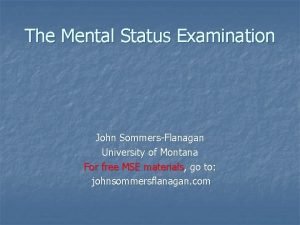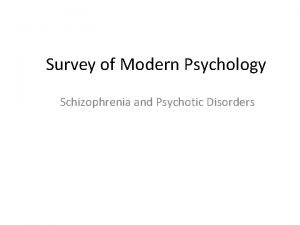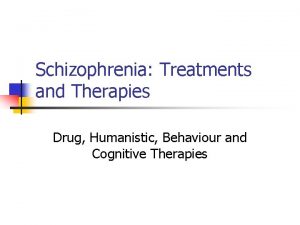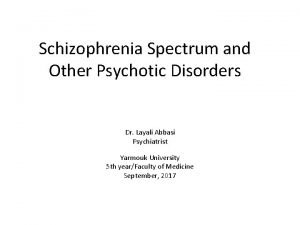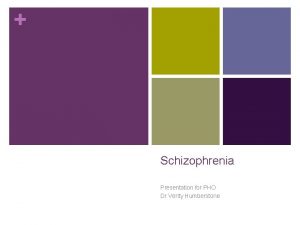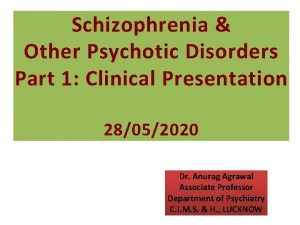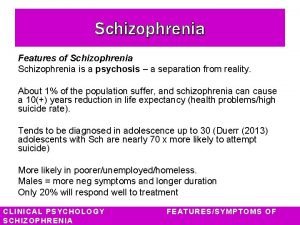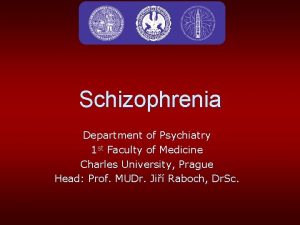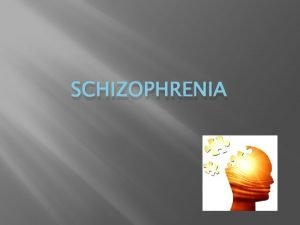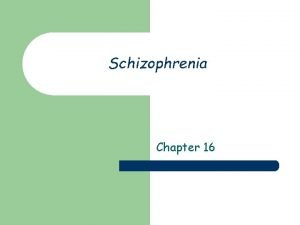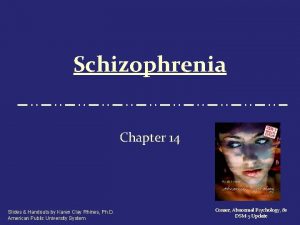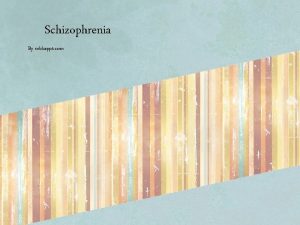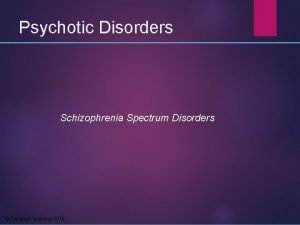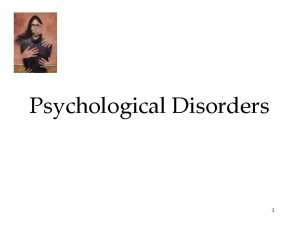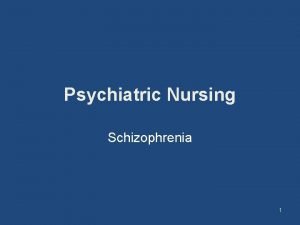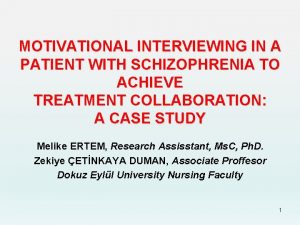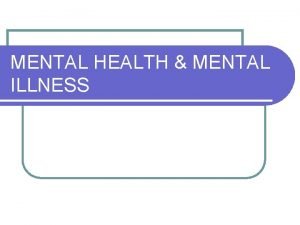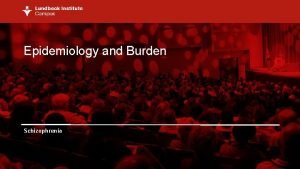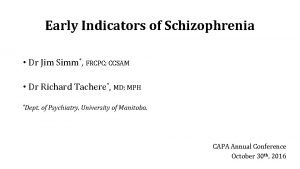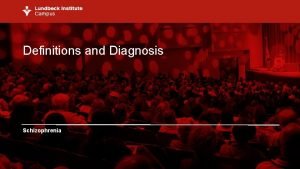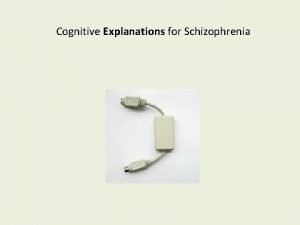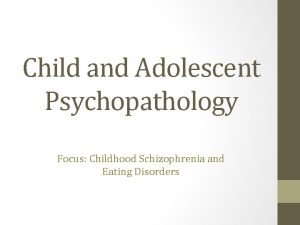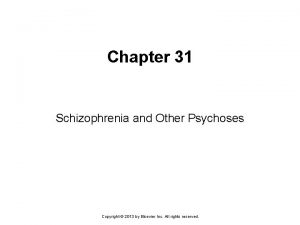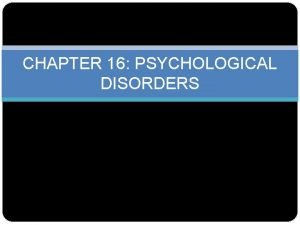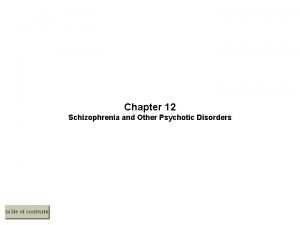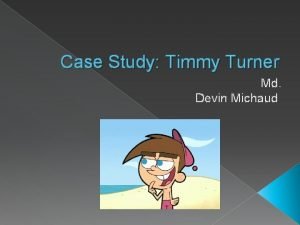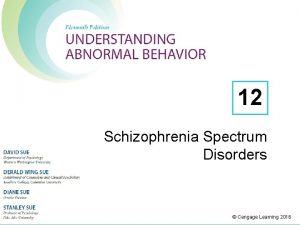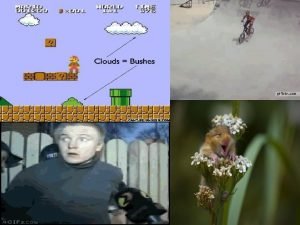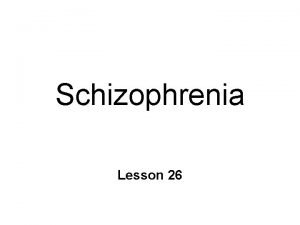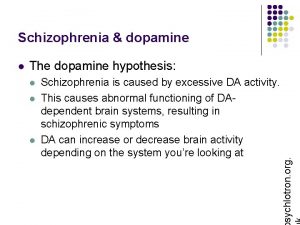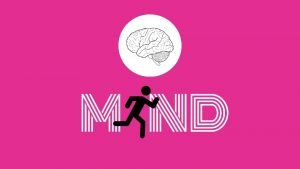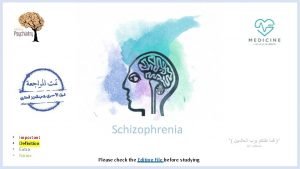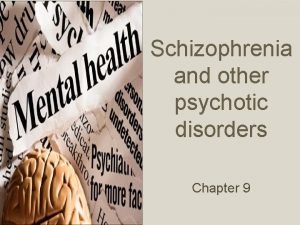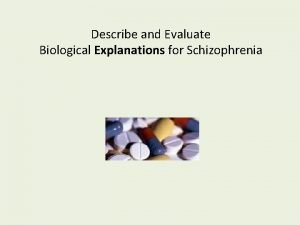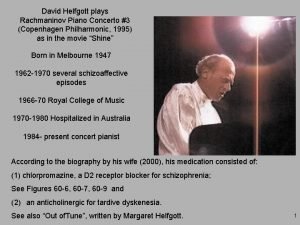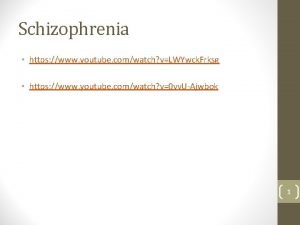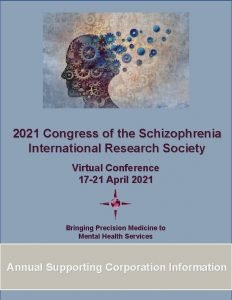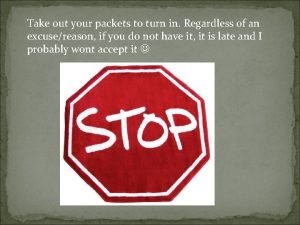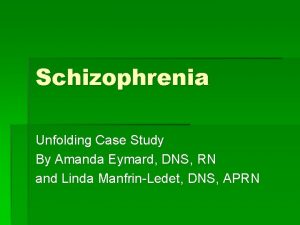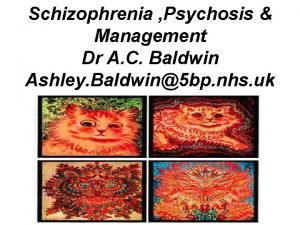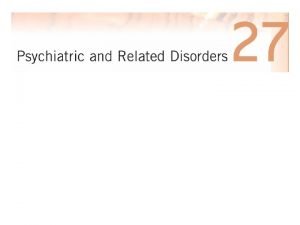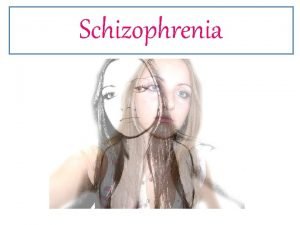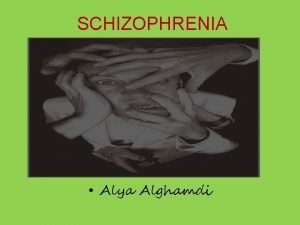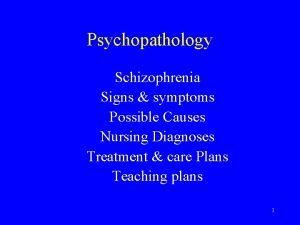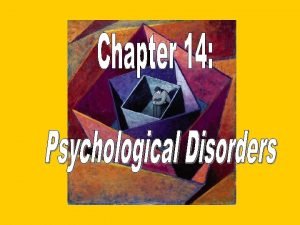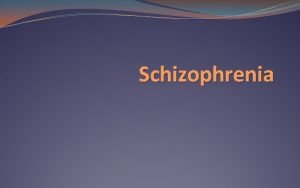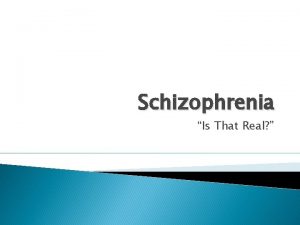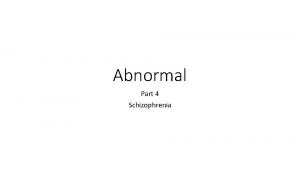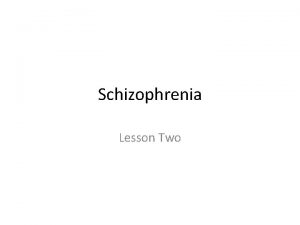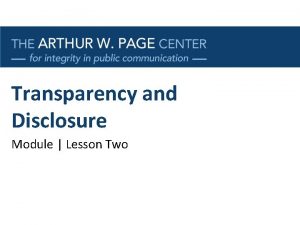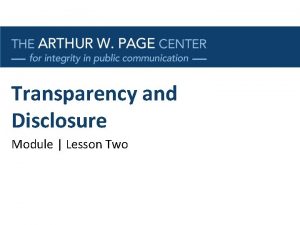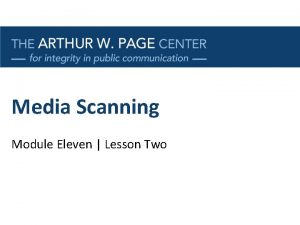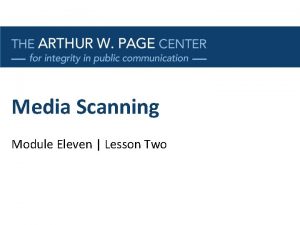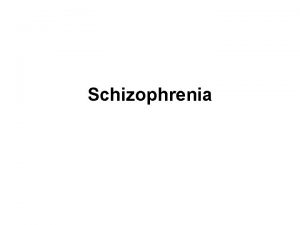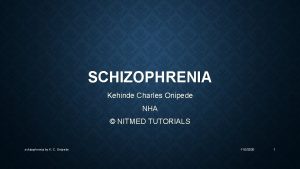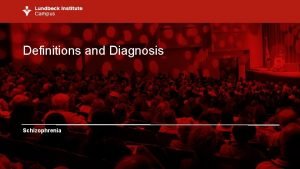Module Two SCHIZOPHRENIA Lesson 1 What is schizophrenia






































































- Slides: 70

Module Two SCHIZOPHRENIA Lesson 1: What is schizophrenia and who it is manifested (2 training hours) n Lesson 2: How the patient himself experience Schizophrenia (2 training hours) n Lesson 3: What are the causes of Schizophrenia (2 training hours) n Lesson 4: Ways of treatment for Schizophrenia (2 training hours) n Lesson 5: Schizophrenia and Family (2 training hours) n Lesson 6: Other psychotic disorders (1 training hour) n TOTAL TIME: 11 TRAINING HOURS OF 45 MINUTES n

Lesson 1 WHAT IS SCHIZOPHRENIA AND HOW IT IS MANIFESTED TIME : 90 minutes (2 training hours of 45 minutes)

Step 1: Introduction (5΄) The subject of Schizophrenia preoccupy the society and attracts the Media. Unfortunately what is said or written is often inaccurate and create false impressions, which, in their turn, block the more efficient treatment of this serious problem.

Step 2: Brainstorming and discussion (15΄) Write everything you know, you have heart or read regarding to Schizophrenia.

Step 2 (continued) • • • The person that suffers from Schizophrenia has not got “split mind” or “dual personality” He is not “dotty”, “nutty”, cracked” or “loony” etc. these terms are not used in Psychiatry. He is no a criminal or violent. His disease is not a punishment for his parents sins. This did not occur because of his improper sexual behavior The fact that there is no treatment is mistaken.

Step 2 (continued) Schizophrenia is: • A serious mental disorder • It belongs to psychotic disorders. • Influences the way in which the person think, feels and behaves. • It is usually manifested to young persons but sometimes can also be manifested to middlesaged, or even elderly. • From this disorder suffer about one every hundred persons.

Step 3: Slide projection and discussion (25΄) Slide 2. 1. 1: Symptoms of Schizophrenia n POSITIVE SYMPTOMS Aberrant ideas (hallucinations) Delusions Disorganized speech Abnormal behavior n NEGATIVE SYMPTOMS Reduction of emotions Poor content of though and speech Lack of desire and pleasure

Step 3 (continued) Slide 2. 1. 2: different types of Schizophrenia n n n Paranoid Catatonic Disorganized Undifferentiated Residual

Step 4: Exercise (15΄) leaflet 1. 1: Clinical case Mark with the sign + the characteristics you consider that have positive prognostic significance and with the sing – those you think that have negative.

Step 5: Slide Projection (20΄) Slide 2. 1. 3: Clinical case (-) It is about a man. (-) In young age. (+) He suffers after the failure in exams and relapsed after his grandfather’s death. (-) It is not clear when exactly his disease was manifested. (-) He isolated a few months before he got sick.

Step 5 (continued) (-)between two incidents he could not work. (+) Among other symptoms he manifests depression. (-) His symptoms responded to the treatment slowly. (+) Nobody in the family suffered from Schizophrenia. (+) The father had manifested depression.

Step 5 (continued) Slide 2. 1. 4: Factors that influence negatively the progress of Schizophrenia? n Insidious outbreak n Onset in early age n Isolation before the manifestation of the disorder n Male gender n Απουσία εκλυτικών γεγονότων n Absence of emotional elements n Long duration of acute phase

Step 5 (continued) n n n Important functionality decrease Many residuary elements Coexistence of neurological diseases Existence of family history retreat from reality(? ) Substance use

Step 6: Questions and Comments (5΄)

Step 7: Lesson’s evaluation (5΄)

Lesson 2 HOW THE PATIENT HIMSELF EXPERIENCE SCHIZOPHRENIA TIME : 90 minutes (2 training hours of 45 minutes)

Step 1: Introduction (5΄) It is really important to try to understand how exactly thinks and feels a person who is under the effect of hallucinating disorders and auditory delusions and why his behavior is disordered.

Step 2: Exercise (15΄) Paper and pen While the person A (or B) writes, the B (A) should keep whispering a short phrase that he will invent, with negative content for the person A (or (B).

Step 3: Discussion (10΄) Describe what were you thinking and how did you feel while you were trying to write the letter and what was the quality of your task.

Step 4 : Brainstorming (15΄) Paper and pen Write all the reasons that might lead people with Schizophrenia to aggressive behavior.

Step 5: Exercise (20΄) In what way is influenced the biological, psychological and social efficiency of the person from Schizophrenia?

Step 6: Slide Projection (15΄) Slide 2. 2. 1: Fields of human functionality that might be influenced from Schizophrenia Biological: n Sleep n Nutrition n Mobility n Function of intestines and cysts n Physical health

Step 6 (continued) Psychological: n Perception of other people, objects and the environment. n Mood and emotional reactions n The idea of himself, ability of selfexamination and self esteem n Concentration, thinking and learning n Adaptability

Step 6 (continued) Social: n Communication with other people (verbal or not verbal) n Personal relationships n Manifestation of sexuality n Employment n Entertainment

Step 7: Questions and comments (5΄)

Step 8 : Lesson’s evaluation (5΄)

Lesson 3 CAUSES OF SCHIZOPHRENIA TIME : 90 minutes (2 training hours of 45 minutes)

Step 1: Introduction (5΄) In reality, we do not know yet the causes of Schizophrenia. Scientists have studied many different factors who could possibly explain the reason why people manifest Schizophrenia. At present we have not found a concrete causal factor. But as it appears there are plenty factors that contribute in combination with each other to its manifestation.

Step 2: Exercise (20΄) Leaflet 2. 3. 1: Clinical case List the factors that can influence positively and negatively the development or not of Schizophrenia from B.

Step 3: Slide Projection (20΄) Slide 2. 3. 1: Causal factors of Schizophrenia · Genetic · Neurochemical · Neurodevelopmental · Environmental

Step 4: Exercise (20΄) Leaflet 2. 3. 2: possibility of appearance of Schizophrenia to relatives. Use four different colors for four different levels of high probability of appearance of the disease to relatives of a patient as following: red the persons that have the most possibilities to manifest the disease, orange for those that have the immediately less possibilities, blue for those that have even less, and green for those that are not influenced at all.

Step 5: Slide Projection (15΄) Slide 2. 3. 1: Possibility of manifestation of Schizophrenia to relatives Monozygotic twins (identical twins) 45% (100% similar genetic material) n Immediate family connection - parents, siblings, children - 10% (50% similar genetic material) n Non immediate family connection – uncle, nephew - 3% (25% similar genetic material) Probability of the manifestation of the disease to the general population is estimated to 1%.

Step 6: Questions and Comments (5΄)

Step 7: Lesson’s Evaluation (5΄)

Lesson 4 WHICH IS THERAPEUTICAL TREATMENT OF SCHIZOPHRENIA TIME : 90 minutes (2 training hours of 45 minutes)

Step 1: Brainstorming and discussion (15΄) Paper and pen Describe the problems of a person that suffers from Schizophrenia which require therapeutical intervention.

Step 1 (continued) • • • Symptoms Problems that occur from the duration of the disease Biological consequences to the person Psychological consequences Social difficulties

Step 2: Exercise (10΄) Leaflet 2. 4. 1: Problems and adequate therapeutical interventions Join each problem that appears in the first column with the appropriate therapeutical intervention in the second column.

Step 3: Slide projection and Discussion (20΄) Slide 2. 4. 1: Therapeutical interventions used in Schizophrenia n Antipsychotic medication n Trust relation with therapeutical group n Complete continuous assistance n Ψυχοεκπαίδευση (? ) n Intervention in the family n Intervention in the environment n Supporting therapy

Step 3 (continued) n n n n Group therapy Learning of social skills Cognitive therapy Professional education Work rehabilitation Home ensuring Entertainment

Step 4 : Exercise and Discussion (15΄) Paper and pen Write the advantages and the disadvantages of antipsychotic medication for a schizophrenic person.

Step 4 (continued) Legends spread regarding antipsychotic medication : • The “” are all the same and notorious and we should avoid taking • Τα «ψυχοφάρμακα» are drugs that one can be addicted. • They might be useful for a patient, but they should stop the medication as soon as the symptoms subside.

Step 4 (continued) • • • The medication must always be taken in respect with the doctor’s instructions. Stopping them for no reason increases the possibilities of relapse. Relapses might be also shown while the patient is under the medication but are usually more gentle.

Step 4 (continued) The patients usually want to stop their medication due to one of the following reasons: • Because they cannot suffer the side effects. • Because its reminds them of their disease, • Perhaps because the symptoms have not totally subside even though they are on medication, • or because they cannot drink alcohol, as their doctor have recommended.

Step 5: Slide projection and Discussion (20΄) Slide 2. 4. 2: Common antipsychotic drugs Conventional n Chlorpromazine n n Thiriodazine Triflupromazine Haloperidol Loxapine unconventional n Clozapine n n n risperidone Olanzapine Quetiapine (Largactil) (Melleril) (Stelazine) (Aloperidin) (Loxapac) (Leponex) (Risperdal) (Zyprexa) (Seroquel)

Step 5 (continued) Slide 2. 4. 3: Side effects of antipsychotic drugs n Parkinsonism. n Anxiety n n n n n low blood pressure restlessness muscle stiffness milk secretion sexual dysfunction dry mouth, or constipation or blurred vision Φωτοευαισθησία light sensitiveness? weight gain Κακόηθες σύνδρομο?

Step 6: Questions and comments (5΄)

Step 7: Lesson’s Evaluation (5΄)

Lesson 5 FAMILY AND SCHIZOPHRENIA TIME : 90 minutes (2 training hours of 45 minutes)

Step 1: Discussion (10΄) Can the family cause Schizophrenia?

Step 1 (continued) • • In the past many theories were brought up that put responsibility to the family for the onset of schizophrenia. (Lidz: “schism and skew”, Bateson: “double bind”, κ. ά. ). Today it is commonly acceptable that the family do not cause Schizophrenia, but contrary can have a major role to the efficiency of the treatment.

Step 2: Theory presentation(15΄) The meaning of Expressed Emotion (EE): • The progress of Schizophrenia might be affected by a way the family expresses its emotions towards the patient.

Step 2 (continued) • • Three factors are closely associated with the relapses of the disease. These are the following: negative comments towards the patient aggressive behavior towards him. emotional overreaction? Of the familyΗ συναισθηματική υπερεμπλοκή της οικογένειας In families where these factors appear in a excessive way, are called family with high Expressed Emotion and the danger of relapsing the disease, if they have a schizophrenic member, are extremely high.

Step 2 (continued) • • This theory has been proved by research studies in which were used special evaluation research tools for the communication of the family and the relationship of their members. The high emotional expression of the family influences negatively the evolution of other mental disorders not only Schizophrenia’s. It is a factor that increases stress and consequently aggravates the situation of the patient.

Step 3: Exercise (20΄) Leaflet 2. 5. 1: fragment of family conversation Point out the points that indicate negative judgment, aggressive behavior and overreaction of the family towards the schizophrenic member.

Step 4: theory presentation (10΄) The charge of the family n Even though the interest of Psychiatry is mainly focused on the family’s influence to the disease, the last years it is accepted that the families of schizophrenic persons are also under great pressure, which has negative effects to all the members of the family, included the schizophrenic person.

Step 4 (continued) n n n The families of the persons that manifest schizophrenia at first cannot understand it and later refuse to accept it. They usually wonder if it was their fault or if another member of the family might manifest the disease and want to know which will be its evolution. They need help and information from specialists. The family charge is more important when the symptoms of the patient are more intense (frequent).

Step 5: Discussion (15΄) Which do you consider that are the most common difficulties that face the family of the schizophrenic person.

Step 6: Theory Presentation (10΄) n n n Most of the psychiatric services that are treating schizophrenic persons dispose nowadays a program of therapeutic treatment that includes the relatives. There also specialized programs of Family Therapy for decreasing the tension in the family environment and supporting the family. An important factor to these is training the family in schizophrenia and ameliorating the communication between its members.

Step 7: Questions and comments (5΄)

Step 8: Lesson’s Evaluation (5΄)

Lesson 6 OTHER PSYCHOTIC DISORDERS TIME : 45 minutes (1 training hour of 45 minutes)

Step 1: Slide projection (10΄) Other psychotic disorders: n n n n Schizophreniform Disorder Schizoeffective Disorder Σχιζοσυναισθηματική Διαταραχή Delusional Disorder Brief Psychotic Disorder Not Otherwise Specified Επινεμόμενη Διαταραχή Psychotic Disorder Due to a General Medical Condition Substance-Induced Psychotic Disorder. (alcohol or other substance)

Step 2: Theory Presentation (25΄) Schizophreniform Disorder • • Clinical case (view) alike to schizophrenia, without including necessarily social and functional loss. Duration less than 6 months (or it is schizophrenia). So, it might also be temporary diagnosis at the onset of schizophrenia. 2/3 of the people with this diagnosis, later on will be diagnosed as schizophrenic, while 1/3 recovers. The therapy is the same with the treatment of an schizophrenic episode.

Step 2 (continued) Σχιζοσυναισθηματική Διαταραχή • Coexistence for a period of time of symptoms of schizophrenia and Depression and manifestation of schizophrenic symptoms periodically, while depression symptoms last longer. • Quite inaccurate diagnosis, but it is important that it is better in relation to schizophrenia’s (but worse in relation to depression’s) • Common to women • Treatment regarding to the symptoms (antipsychotic drugs, antidepressants and other psychosocial interventions)

Step 2 (continued) Delusional Disorder • Existence of aberrant ideas (hallucinations), but not delusions. • Aberrant but not bizarre ideas. • Mainly ideas of persecution, grandeur, somatic, jealousy or erotomania (sex-mania). • Usually manifested at middle-age or later. • No sufficient response to antipsychotic medication. Developing a trust relation with therapist and after a series of gentle treatment (handling) it is the best treatment.

Step 2 (continued) Brief Psychotic Disorder • It is called a psychotic episode with symptoms alike to schizophrenia’s that is manifested abruptly and lasts less than a month. • It is a rare disorder mainly manifested to adolescents and very young persons. • The treatment includes antipsychotic medication and supporting psychotherapy.

Step 2 (continued) Psychotic Disorder Not Otherwise Specified • It is a fairly rare situation in which a person (usually relative) that lives close to the schizophrenic person manifests similar aberrant ideas. • Usually manifested to women. • As a therapy, it is recommended the elimination from the psychotic person, so the aberrant ideas subside.

Step 3: Questions and comments (5΄)

Step 4: Lesson’s evaluation (5΄)
 Module 68: schizophrenia
Module 68: schizophrenia Two years ago jenny was diagnosed with schizophrenia
Two years ago jenny was diagnosed with schizophrenia C device module module 1
C device module module 1 Module 9 lesson 2
Module 9 lesson 2 Module 5 lesson 5
Module 5 lesson 5 Grade 8 module 1 unit 1 lesson 6 answer key
Grade 8 module 1 unit 1 lesson 6 answer key Practical/logistical issues in relationships examples
Practical/logistical issues in relationships examples Grade 6 module
Grade 6 module Module eleven lesson one self check quiz
Module eleven lesson one self check quiz Eureka math algebra 1 module 1 lesson 15
Eureka math algebra 1 module 1 lesson 15 Grade 5 module 1 lesson 1
Grade 5 module 1 lesson 1 Module 15 lesson 1 central angles and inscribed angles
Module 15 lesson 1 central angles and inscribed angles Module 3 lesson 6
Module 3 lesson 6 Mental status exam
Mental status exam Schizophrenia
Schizophrenia Schizophrenia warning signs
Schizophrenia warning signs Humanistic approach to schizophrenia
Humanistic approach to schizophrenia Schizophrenia dsm 5
Schizophrenia dsm 5 First-line treatment for schizophrenia
First-line treatment for schizophrenia Bleuler 4a
Bleuler 4a Genain sisters
Genain sisters Types of psychosis
Types of psychosis Schizophrenia thesis statement
Schizophrenia thesis statement Types of schizophrenia
Types of schizophrenia Hebephrenic schizophrenia
Hebephrenic schizophrenia Schizophrenia def
Schizophrenia def Disorganized behavior schizophrenia
Disorganized behavior schizophrenia Example of loose associations in schizophrenia
Example of loose associations in schizophrenia Thought insertion
Thought insertion Phases of schizophrenia
Phases of schizophrenia Double bind
Double bind Acute schizophrenia
Acute schizophrenia Double bind example
Double bind example Associative looseness
Associative looseness Loose associations
Loose associations Motivational interviewing schizophrenia
Motivational interviewing schizophrenia Axis 1-5 mental health
Axis 1-5 mental health Prevalence of schizophrenia
Prevalence of schizophrenia Dr tachere
Dr tachere Reality testing worksheet schizophrenia
Reality testing worksheet schizophrenia Cognitive explanations of schizophrenia
Cognitive explanations of schizophrenia Example of loose associations in schizophrenia
Example of loose associations in schizophrenia Chapter 31 schizophrenia and other psychoses
Chapter 31 schizophrenia and other psychoses Schizophrenia def
Schizophrenia def First-line treatment for schizophrenia
First-line treatment for schizophrenia Devin michaud
Devin michaud Undifferentiated schizophrenia
Undifferentiated schizophrenia Schizophrenia def
Schizophrenia def Chapter 12 schizophrenia spectrum disorders
Chapter 12 schizophrenia spectrum disorders Catatonic schizophrenia
Catatonic schizophrenia Loose associations
Loose associations Dopamine hypothesis of schizophrenia ppt
Dopamine hypothesis of schizophrenia ppt What is schizophrenia
What is schizophrenia What causes schizophrenia
What causes schizophrenia Definition of schizophrenia
Definition of schizophrenia Schizophrenia
Schizophrenia Biological explanations of schizophrenia
Biological explanations of schizophrenia Genes schizophrenia
Genes schizophrenia Symptoms of schizophrenia
Symptoms of schizophrenia Sirs conference 2021
Sirs conference 2021 Free verse poem examples
Free verse poem examples Types of schizophrenia
Types of schizophrenia Is schizophrenia genetic
Is schizophrenia genetic Delusional thinking
Delusional thinking Schizophrenia
Schizophrenia Duman
Duman Statistics of schizophrenia
Statistics of schizophrenia Schizophrenia
Schizophrenia Alya alghamdi
Alya alghamdi Thought insertion
Thought insertion I think i have schizophrenia
I think i have schizophrenia
